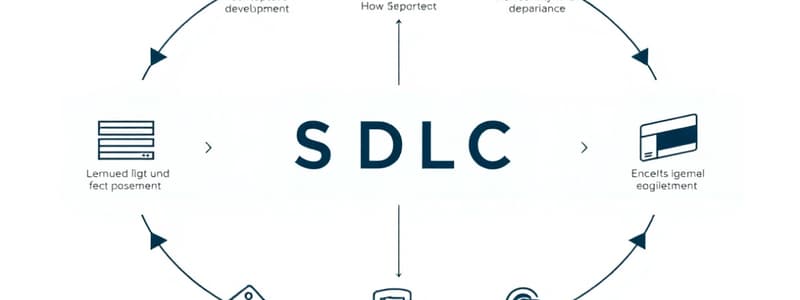Podcast
Questions and Answers
Which SDLC phase focuses primarily on defining the 'what' of the system rather than the 'how'?
Which SDLC phase focuses primarily on defining the 'what' of the system rather than the 'how'?
- Requirements Gathering (correct)
- Implementation
- Testing
- Design
In which SDLC phase are unit tests typically developed and executed?
In which SDLC phase are unit tests typically developed and executed?
- Implementation (correct)
- Design
- Deployment
- Maintenance
What is the primary goal of performing system testing during the SDLC?
What is the primary goal of performing system testing during the SDLC?
- To optimize the performance of individual algorithms.
- To verify that each individual code module functions correctly in isolation.
- To ensure that the entire system meets the specified requirements and functions as expected in a real-world environment. (correct)
- To automatically generate code documentation.
Which of the following activities would be LEAST relevant during the 'Maintenance' phase of the SDLC?
Which of the following activities would be LEAST relevant during the 'Maintenance' phase of the SDLC?
Considering the entire SDLC process, which factor generally has the HIGHEST impact on the overall cost and timeline of a software project?
Considering the entire SDLC process, which factor generally has the HIGHEST impact on the overall cost and timeline of a software project?
Flashcards
What is the SDLC?
What is the SDLC?
A step-by-step process for building software, from start to finish.
What are the SDLC phases?
What are the SDLC phases?
Planning, Analysis, Design, Implementation, Testing, and Maintenance.
What is the Planning phase?
What is the Planning phase?
Deciding what the software should do and identifying project goals.
What is the Analysis phase?
What is the Analysis phase?
Signup and view all the flashcards
What is the Design phase?
What is the Design phase?
Signup and view all the flashcards
Study Notes
- The Software Development Lifecycle (SDLC) is a structured process for producing high-quality software.
- SDLC provides a framework for managing the complexities of software development.
- A well-defined SDLC helps to ensure that the final product meets the specified requirements and objectives.
- SDLC helps to deliver a software product on time and within budget.
Common SDLC Phases
- Requirement analysis phase involves gathering and documenting the needs of the stakeholders.
- This phase is critical because errors made here can propagate through the entire process.
- Requirements should be specific, measurable, achievable, relevant, and time-bound (SMART).
- Design phase translates the requirements into a detailed blueprint for the software.
- Design includes architectural design, database design, interface design, and algorithm design.
- Good design is modular, scalable, and maintainable.
- Implementation (coding) phase involves writing the actual code based on the design.
- Coding should adhere to established coding standards and best practices.
- Code should be well-documented for easier understanding and maintenance.
- Testing phase verifies that the software functions correctly and meets the specified requirements.
- Testing includes unit testing, integration testing, system testing, and user acceptance testing.
- Thorough testing is essential to identify and fix bugs before deployment.
- Deployment phase involves releasing the software to the intended users.
- Deployment activities include installation, configuration, and data migration.
- Post-deployment support and maintenance are also crucial.
- Maintenance phase involves fixing bugs, releasing updates, and adding new features.
- Maintenance ensures that the software remains functional and meets evolving needs.
- Maintenance includes corrective, adaptive, perfective, and preventive maintenance.
SDLC Models
- Waterfall model is a linear, sequential approach where each phase must be completed before the next one begins.
- This model is simple to understand and implement.
- Waterfall model is suitable for projects with well-defined requirements.
- It is not flexible to changes in requirements.
- Iterative model involves developing the software in small, incremental steps.
- Each iteration includes all the phases of the SDLC.
- Iterative model allows for early feedback and reduces risk.
- Spiral model combines elements of the waterfall and iterative models.
- Spiral model emphasizes risk analysis and management.
- It is suitable for complex projects with evolving requirements.
- Agile model emphasizes flexibility, collaboration, and customer satisfaction.
- Agile model involves short development cycles (sprints) and frequent releases.
- It is suitable for projects with rapidly changing requirements.
- DevOps model emphasizes collaboration and automation between development and operations teams.
- DevOps model aims to shorten the development lifecycle and improve software quality.
- It involves practices such as continuous integration, continuous delivery, and continuous deployment.
Requirement Analysis Phase Details
- Requirement elicitation involves gathering requirements from stakeholders through interviews, surveys, and workshops.
- Requirement documentation involves writing down the gathered requirements in a structured format, like use cases or user stories.
- Requirement validation involves verifying that the documented requirements are correct, complete, and consistent.
- Use cases describe how users will interact with the system to achieve specific goals.
- User stories are short, simple descriptions of a feature told from the perspective of the user.
- Requirements traceability ensures that each requirement can be traced back to its source and forward to its implementation and testing.
Design Phase Details
- Architectural design defines the overall structure of the software system, including its components and their interactions.
- Database design defines the structure of the database that will store the software's data, including tables, fields, and relationships.
- Interface design defines the look and feel of the software's user interface, including menus, buttons, and forms.
- Algorithm design defines the step-by-step procedures that the software will use to solve specific problems.
- UML (Unified Modeling Language) is a standard notation for modeling software systems.
- Design patterns are reusable solutions to common software design problems.
Implementation Phase Details
- Coding standards are a set of guidelines for writing code that is consistent, readable, and maintainable.
- Code reviews involve having other developers examine your code to identify potential problems.
- Version control systems (e.g., Git) are used to track changes to the code over time.
- Unit testing involves testing individual components of the software to ensure that they function correctly.
- Debugging is the process of identifying and removing errors from the code.
Testing Phase Details
- Unit testing tests individual components in isolation.
- Integration testing tests the interactions between different components.
- System testing tests the entire software system to ensure that it meets the specified requirements.
- User acceptance testing (UAT) involves having end-users test the software to ensure that it meets their needs.
- Test cases are detailed specifications of the inputs, expected outputs, and execution conditions for a test.
- Test coverage measures the extent to which the code has been tested.
- Bug reports document the details of bugs that have been found during testing.
Deployment Phase Details
- Deployment planning involves creating a plan for deploying the software to the intended users.
- Installation involves copying the software files to the target environment.
- Configuration involves setting up the software to work correctly in the target environment.
- Data migration involves moving data from the old system to the new system.
- Training involves teaching the users how to use the new software.
- Go-live is the point at which the new software is put into production.
Maintenance Phase Details
- Corrective maintenance involves fixing bugs that have been found after deployment.
- Adaptive maintenance involves modifying the software to work with new hardware or software.
- Perfective maintenance involves improving the performance or usability of the software.
- Preventive maintenance involves making changes to the software to prevent future problems.
- Software updates are released to fix bugs, add new features, or improve performance.
- Patch management is the process of installing and managing software updates.
Choosing the Right SDLC Model
- Project requirements, complexity, and risk are all important factors to consider.
- Waterfall model is suitable for projects with well-defined, stable requirements.
- Iterative model is suitable for projects with evolving requirements or limited resources.
- Agile model is suitable for projects that require flexibility and collaboration.
- Spiral model is suitable for projects with high risk or complex requirements.
- No single SDLC model is perfect for all projects.
- The best SDLC model is the one that best fits the specific needs of the project.
Studying That Suits You
Use AI to generate personalized quizzes and flashcards to suit your learning preferences.




